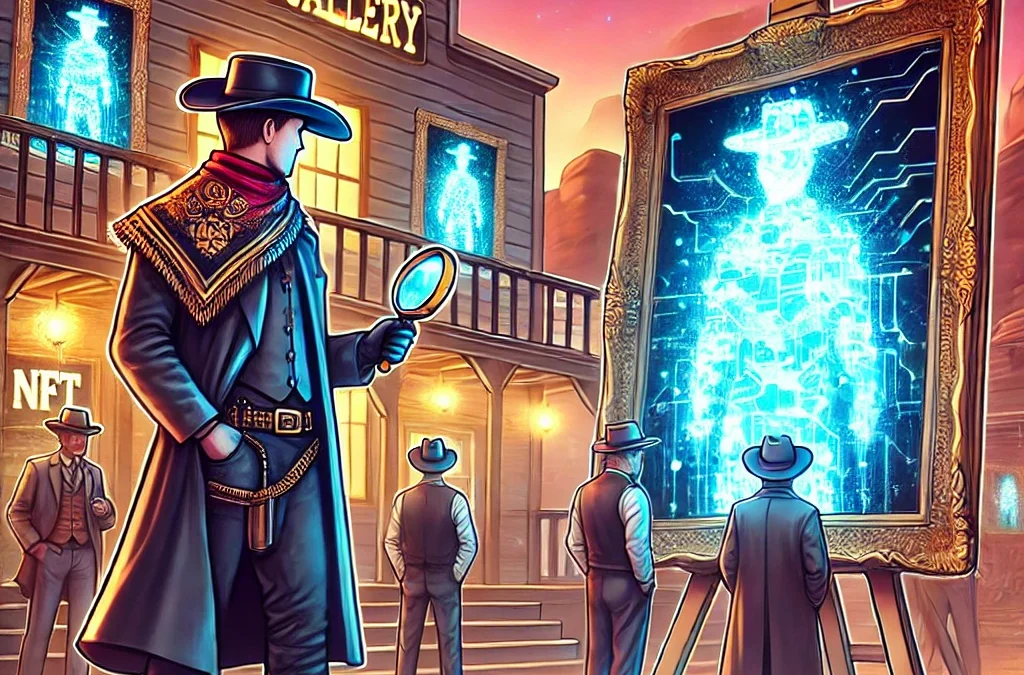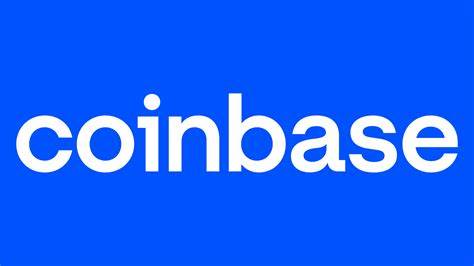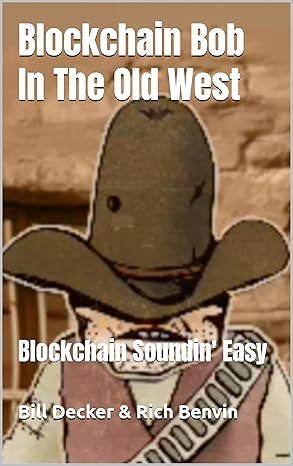Blockchain Bob and the Mystery of the Phantom Paintings
Out in the dusty town of Blocksville, there were a few things folks could count on: scorching days, cold sarsaparilla, and the legendary cowboy, Blockchain Bob, always finding a way to turn crypto confusion into clarity. But this time, the challenge ahead was something no one had ever seen before: Phantom Paintings.
One fine morning, Blocksville’s local artist, Picasso Pete, came rushing into the saloon, wild-eyed and holding what looked like an empty frame. “It’s gone! Just vanished!” he hollered, waving the frame around like it had something to say. “I sold my painting, but now no one can see it!”
The whole saloon fell quiet as folks tried to make sense of Pete’s strange predicament. “What’re you talkin’ about, Pete?” asked the barkeep, wiping down the counter. “Paintings don’t just disappear.”
Pete set the frame on the counter. “This here was supposed to be my masterpiece, sold to the highest bidder for a fortune in crypto. But the buyer says they don’t see nothin’—like it never existed!”
That’s when Bob, sitting in his usual spot by the window, tipped his hat and strolled over. “Sounds to me like you’re dealin’ with a case of misplaced NFTs,” he said with a grin.
Pete scratched his head. “NFTs? What in tarnation is that?”
Bob leaned on the bar and gave Pete a knowing look. “Well, Pete, NFTs—Non-Fungible Tokens—are like digital certificates of ownership. They don’t exist in the real world, but they’re tied to unique assets, like your painting, on the blockchain. It’s how artists like you can sell digital works, but here’s the kicker—it ain’t about the painting itself, but the ownership of it.”
Pete looked puzzled. “But if the painting’s right here, how come the buyer can’t see it?”
Bob chuckled. “Because it’s not the physical painting they bought—it’s the NFT that proves they own it. Think of it like this: back in the old days, when folks struck gold, it wasn’t always the nugget they carried around; it was the deed that said they owned the mine.”
The crowd started to gather, intrigued by the lesson.
“So, let me get this straight,” Pete said. “The buyer don’t need the actual painting—they just need this NFT to prove it’s theirs?”
“That’s right,” Bob said. “NFTs are one-of-a-kind digital tokens that represent ownership of something unique—could be artwork, music, even land in the digital world. Once it’s minted on the blockchain, it’s locked in. Can’t be copied, can’t be replaced. And anyone can see the ownership record on the blockchain ledger.”
Pete frowned. “But how do I know the buyer didn’t steal the NFT or copy it?”
Bob shook his head. “That’s the beauty of it. The blockchain makes sure no one can duplicate or mess with ownership. Once it’s minted as an NFT, only the rightful owner has control, and the whole town—well, the whole world—can see who owns it by checking the ledger. No need to worry about fakes or thieves.”
One of the townsfolk, Miss Clara, chimed in. “But what if someone just screenshots the painting or takes a copy? Doesn’t that mean they can steal it?”
Bob smiled. “Well, Miss Clara, they might be able to take a picture of it, just like someone can take a photo of a real painting. But that doesn’t mean they own the original. The NFT proves who holds the actual ownership. And that, folks, is worth more than any copy could ever be.”
The crowd murmured in agreement, starting to see the value in Pete’s missing masterpiece.
“But what about my buyer?” Pete asked. “How do I make sure they know they got what they paid for?”
“That’s easy,” Bob said, pulling a small gadget from his belt. “You just need to make sure the NFT is transferred properly on the blockchain. Once the transaction is done, the buyer will see their new NFT sittin’ safe in their digital wallet, along with proof that they own the real deal.”
Pete looked down at his empty frame, a slow grin spreading across his face. “So, even though they can’t hang it on their wall, they’ve got proof they own my masterpiece?”
“Exactly,” Bob said, tipping his hat. “And now that you know the ropes, you can sell more of your artwork as NFTs. Artists all over the world are usin’ NFTs to sell digital work, and collectors are flockin’ to buy ’em. It’s the new way to trade in this wild frontier of blockchain.”
Pete straightened up, newfound confidence in his step. “Well, I reckon I’ll get back to painting, then. But this time, I’ll mint ‘em as NFTs first.”
Bob gave Pete a friendly slap on the back. “That’s the spirit, partner. NFTs are the future, and as long as you’ve got the blockchain on your side, your art’ll live forever in the digital world.”
As Pete rushed off to mint his next masterpiece, the townsfolk gathered around Blockchain Bob, grateful for another lesson learned in the ever-expanding world of blockchain.
“Remember, folks,” Bob said with a smile, “NFTs may not be something you can hang on the wall, but they sure as shootin’ prove ownership in the digital frontier. So, if you’re sellin’ your work online, make sure you know the difference between a copy and the real deal—’cause that’s where the value lies.”
With that, Bob tipped his hat once more and strode off into the sunset, leaving the good people of Blocksville a little wiser and ready to tackle the next challenge the blockchain might throw their way.
Crypto Lesson: NFTs (Non-Fungible Tokens) are unique digital assets that prove ownership of something valuable, whether it’s digital art, music, or even real estate in the virtual world. The value of an NFT lies not in the copy of the asset, but in the proof of ownership recorded on the blockchain, which ensures authenticity and rarity. So, if you’re buying or selling digital work, make sure you understand how NFTs work and where the real value lies.



